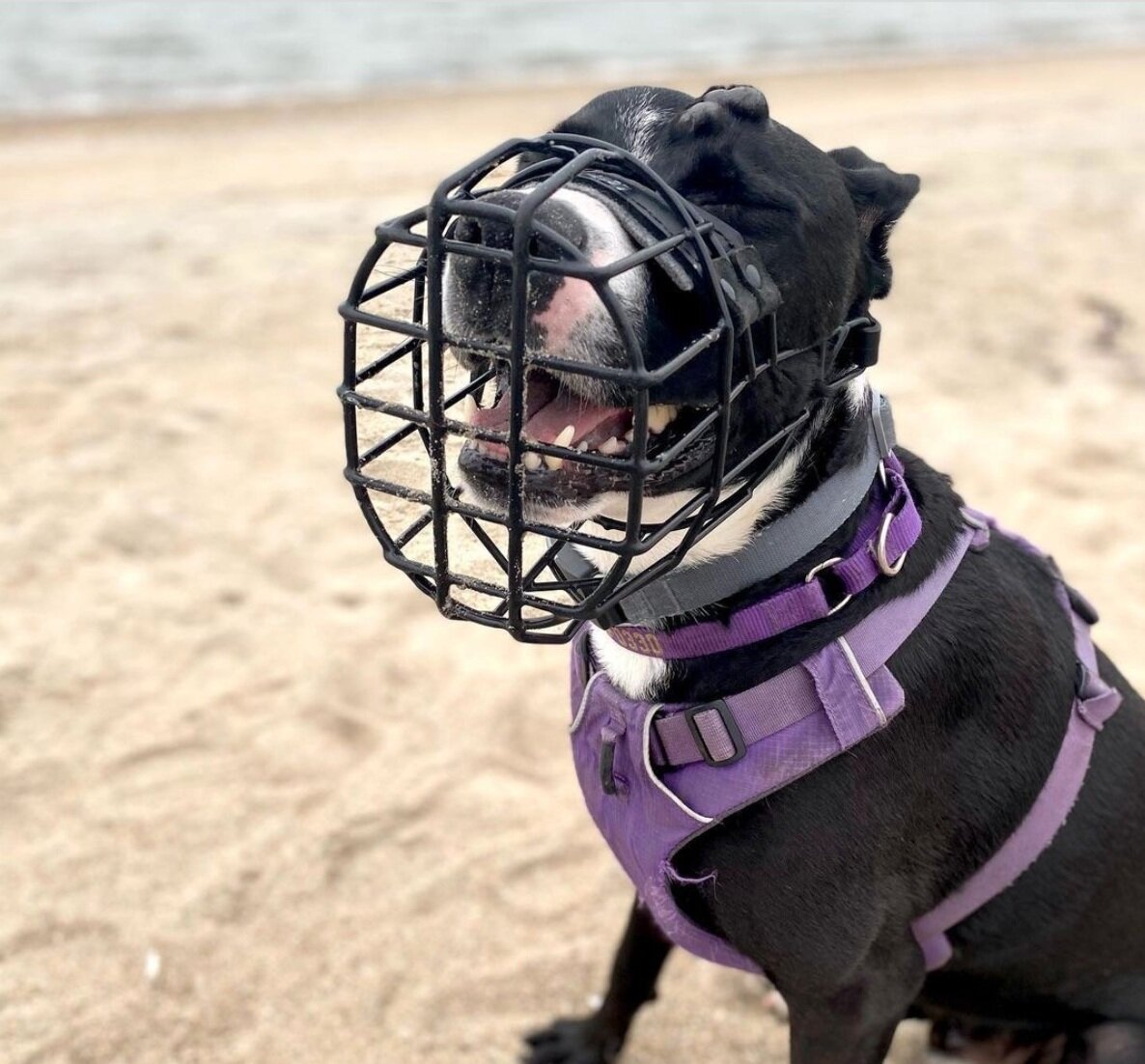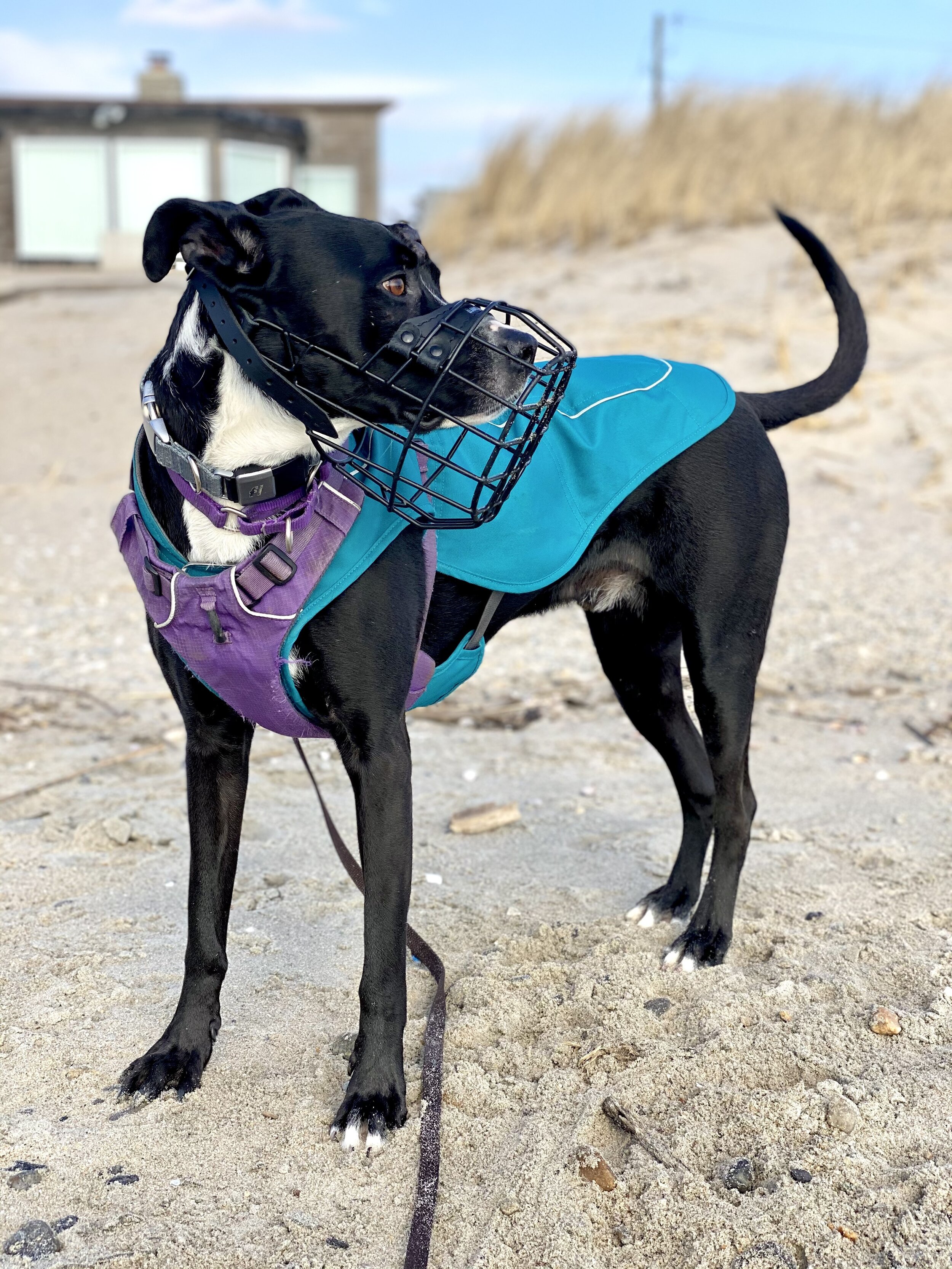The Truth About Muzzles
Source: Instagram, @mr_mushu_pork
Let's talk muzzles! A helpful and sometimes misunderstood tool, muzzles are often seen in a negative light. Yet muzzle training can help a pup live their best and most fulfilling life!
Meet Mushu, a Muddy Paws alum who was adopted in 2017. Mushu (formerly known as Harry Potter, named for the scar on his forehead) was only 6 months old when I adopted him. I had dogs my entire life and thought I was fully ready for a puppy of my own to raise, but woof, I had no idea what I was doing!
There are so many factors that have contributed to muzzle training Mushu. Between him being in a shelter for a major socialization period of his life, to being attacked twice at the dog park, to the drastic life changes we’ve been through, Mushu became fear reactive towards big dogs. Once the fear reactivity started, it developed into a serious issue rather quickly.
One day I had Mushu off-leash on the beach at my mom’s house, a place where I fully trusted him. Another off-leash dog came out of nowhere and tried to go after Mushu’s tennis ball. As a result, Mushu went after the dog. Thankfully no dogs were hurt, but it was very scary to not only see Mushu cause this, but to not be able to physically remove him from the fight because of his sheer strength. I was beyond frustrated and upset with him and I felt like such a failure as a dog mom. I had no idea where to go from there.
That same day I noticed a dog account I follow on Instagram post about muzzle training their foster dog. They talked about it in such a positive light that I reached out to get more information. Countless hours of research later, I realized there was an entire muzzle community out there, and that Mushu and I weren’t alone!
I realized if I couldn’t stop Mushu from trying to bite, I needed to stop him from having the option to bite altogether. So I did what most people do: I went online and bought a cheap muzzle (which honestly fit terribly, but I didn’t know any better). I was so excited that I immediately rushed to put the muzzle on Mushu! Unfortunately, Mushu didn’t understand why I was putting something on his face and became understandably scared when he saw the muzzle come out. Thanks to the pandemic keeping me home, I spent the entirety of the next 3 months dedicated to muzzle conditioning.
Muzzle conditioning was a slow process—I had to undo the fear I had already caused and was pretty nervous about how badly I messed up. It started with teaching Mushu that the muzzle = treats! I would show him the muzzle and reward him with a bunch of treats without asking him to do anything. He eventually realized something positive would happen when he saw the muzzle, so he stopped trying to walk away.
Slowly, I transitioned to rewarding Mushu when he touched the muzzle. Eventually, by holding a treat inside the muzzle, I was able to encourage him to put his own face in it. Once he was confident enough to do this on cue, I would smear peanut butter all over the muzzle for a longer-lasting treat while I secured the muzzle to his head. Once I was confident in our conditioning, I focused on building up the amount of time he wore it. Still trying to create positive associations, I would have him wear it on one walk every day and during playtime with other dogs—two things he absolutely loves! After a few muzzled playdates with neighbors and family, Mushu realized the muzzle allowed him to play with other dogs without me hovering and he became excited to have it on!
Knowing Mushu couldn’t hurt another dog took such a huge stressor off of me that I could really focus on his reactivity training without my fears projecting additional stress. Thanks to the incredible muzzle community, I quickly learned the muzzle I bought was too small, not bite-proof, and ultimately not very comfortable for Mushu because the hard plastic material would rub his skin raw. Now that I know the importance of having proper pant room and understand bite-proof vs. non-bite-proof muzzles, I’ve upgraded to a fancier wire basket muzzle. When the new muzzle arrived, I started muzzle conditioning again from the beginning! This time only took about an hour instead of several months because Mushu understood the concept, and the first thing he did was take a nap while wearing it—because it’s really that comfortable for him! That’s the moment I knew all our hard work was paying off.
I now muzzle Mushu when new people are coming into our home—workers, friends, etc.—and when we meet new dogs (including fosters, which could mean he wears the muzzle for several days at a time). I also muzzle for non-reactive reasons! When the snow started to melt, the streets were covered in garbage and dog poop, so I muzzled Mushu on walks so he couldn’t eat anything and make himself sick. I love muzzling him when we play with basketballs or soccer balls because it extends the life of the ball by days! Sometimes I muzzle him simply because I don’t want to talk to people on our walks, and the muzzle is a clear sign we need space. I always bring it to the vet in case we run into another large dog, although I’ve actually never needed it there. The muzzle can also be used in place of the ‘cone of shame’ should Mushu ever need one, which is great because have you seen how big those cones are for large dogs?! Ultimately, in the case of an emergency, Mushu knows how to wear a muzzle, and it’s one less stressor in already difficult situations.
If you’re ever questioning whether to muzzle or even just looking to learn more, I highly recommend surrounding yourself with pro-muzzle people! Whether that’s following them on Instagram, Facebook, or joining some pro-muzzle groups, it doesn’t feel nearly as scary when you know you’re not alone. Muzzle Training and Tips is by far the best group I’ve found. This group is run by professionals, so your responses will always be from people who really know what they’re talking about, and who also care that your needs are met. They care about why you’re looking to muzzle train, help determine what the best type of muzzle is for you, and make sure your muzzle fits correctly and safely so it doesn’t limit your dog from panting or activity.
I love that I now have the confidence to really advocate for my dog, not only when he’s wearing the muzzle but also when he’s not. I love that using a muzzle means we can safely foster dogs, and Mushu can have safe playdates and meet new people—all without me constantly stressed about whether he will react. His reactivity won’t ever go away, but the muzzle was the first step in managing and training reactivity in a way that keeps everyone safe, Mushu included.
Source: Instagram, @mr_mushu_pork
Haley Wilson is a dedicated Muddy Paws foster, adopter, and volunteer. She invites anyone with questions about muzzling to reach out to her on Instagram.








